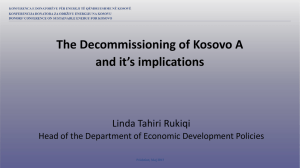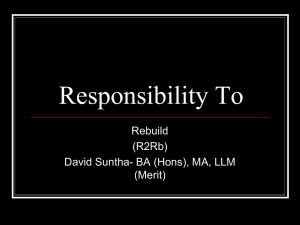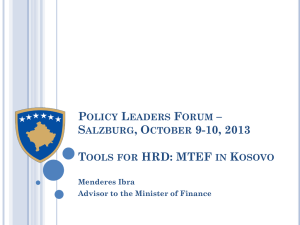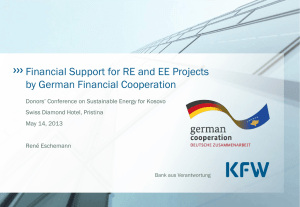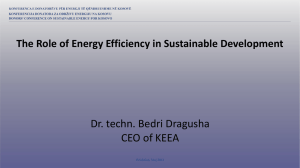MyderriziArzana esentation_2013-08
advertisement
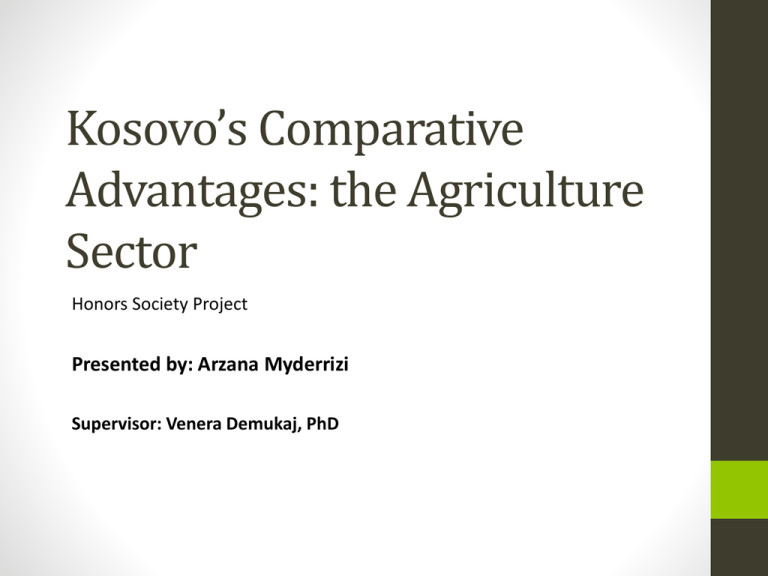
Kosovo’s Comparative Advantages: the Agriculture Sector Honors Society Project Presented by: Arzana Myderrizi Supervisor: Venera Demukaj, PhD Agenda • • • • Statement of Problem Background to the Research Problem Research Conducted The Findings of the Research • • • • • • Kosovo’s barriers in exporting its products Kosovo in CEFTA Agriculture as a solution Can agriculture be a source of development in Kosovo? Two success stories(APC and Ask Foods) Government’s support for the agriculture sector • Conclusion • Recommendations Statement of Problem • Trade deficit presents an ongoing concern for the economy of Kosovo • The trade deficit is financed largely by remittances and second generation migrants who are expected to decrease their transfers to Kosovo • The aim of this report is to examine the comparative advantages that Kosovo has in the agriculture sector. The comparison is drawn between Kosovo and other states in the region • For this purpose, new qualitative and quantitative data were gathered through face-to-face interviews, case studies, and a small-scale survey • The main motivation for this report stems from the fact that Kosovo suffers from a persistent trade deficit, with a slow export growth rate and low diversification of exports Background to the Research Problem The Theory of Comparative Advantage By David Ricardo No matter the size of the economy, there will always be gains from trade, as long as countries open themselves to free trade regimes. If one country is relatively better at producing a good, it should specialize in producing that particular good, and export it in order to pay for the good that it imports, for which the other country is relatively better at producing. So, all the countries will produce and export the goods for which they have cost advantages and import the cost-disadvantageous goods Background to the Research Problem • In 2011, Kosovo’s imports were worth of €2.48 billion, its exports were worth of only €312.5 million, leading to a trade deficit of €2.17 billion • The share of trade deficit to GDP in 2010 was 43.9% of GDP, which in 2011 increased to 50.9% of GDP Kosovo’s trade balance (in million euros) 2008-2011; Source: CBK (2012) Background to the Research Problem (cont.) Main categories of Kosovo’s imports Source: CBK (2012) Main categories of Kosovo’s exports Source: CBK (2012) Background to the Research Problem (cont.) • Kosovo trades mostly with the EU countries and member countries of CEFTA • 73.8% of total trade exchanges were made with the EU and members of CEFTA • The largest share of imported goods, within CEFTA members, comes from Macedonia (14.7 %) and Serbia (10.9%) Structure of exports by trading partners (in percent); Source: CBK (2012) Background to the Research Problem (cont.) • Kosovo has a surface area of 1.1 million hectares of land, out of which 53% is arable with the remaining 41% composed of forests and mountains. • 13% of Kosovo’s total GDP is generated from the agricultural sector, which also accounts for 16% of total exports. • From 2005 to 2008 agro-food imports increased by 68%, from €280 million in 2005 to €470 million in 2008. Kosovar Agro-Food Trade, 2005-2008; Source: World Bank, 2012 Background to the Research Problem (cont.) Advantages of Kosovo’s Agriculture Sector • The geographical position of Kosovo puts it quite close to other EU regional markets. • Kosovo has great potential to increase its productivity since “it currently lags behind European benchmark countries in cropping intensity (0.9), yield per hectare (20), and export value per harvested hectare (€25).” • Kosovo also receives donations for its agricultural sector enhancement (around €15–18 million per year) • Kosovo has an advantage of a growing season, which supports harvesting around 30 days before that in northern Europe. Research Conducted • The qualitative secondary research includes mostly reports from the World Bank, the Central Bank, USAID, and GAP Institute for Advanced Studies • As part of the qualitative primary research, this report includes five interviews with experts in the field and two with local exporting companies • The quantitative analysis was conducted in the form of a small-scale survey Research Conducted (cont.) Interviews with Experts Interviews with Companies -Ekrem Gjokaj, Head of Department for - Artin Nimoni, Ask Foods - Shkelzen Shabani, AgroProduct Commerce (APC) Economic Analysis and Agricultural Statistics, Ministry of Agriculture, Forestry, and Rural Development; -Ardian Kryeziu, Deputy Chief of Party & Trade Component Lead, USAID Business Enabling Program; -Petrit Gashi, PhD, Professor of International Trade, University of Prishtina-Faculty of Economics; and -Artane Rizvanolli, PhD, Senior Researcher, Riinvest. - Sytrime Dervisholli, Head of Trade Agreements Division, Ministry of Trade and Industry Research Conducted (cont.) Small-scale Survey • 20 local companies were included in the survey • The questionnaire had 7 questions Product Categories Fruits and Vegetables 25% Other 55% Dairy Products (milk, cheese) 20% The Findings of the Research KOSOVO’S BARRIERS IN EXPORTING ITS PRODUCTS Experts' Opinion Companies' Opinion -lack of an appropriate, clear and predictable regime for export and import -huge competition in the regional and EU markets -insufficient production for export -access to finances -not meeting the necessary EU standards -the imposition of tariffs by transit countries -low-quality packaging -huge competition in the foreign market -high cost of production -high transportation costs -insufficient support from the government The Findings of the Research (cont.) KOSOVO’S BARRIERS IN EXPORTING ITS PRODUCTS Exporting Countries 2 companies export their products to the Balkans, the EU, and other countries; 5 companies to the Balkans and the EU, and 5 other companies only to the Balkans Other 11% Balkans Balkans and the EU Balkans, EU, and Other Main Obstacles for Exporting High cost of production 29% Competition in the foreing market 29% High transportation costs The Findings of the Research (cont.) KOSOVO IN CEFTA CEFTA's Effect on Kosovo's Trade Balance Experts’ Opinion -Kosovo was never really a member of CEFTA -no significant changes in the trade balance -not much benefits due to the well-known political issues -the effects on imports (and competition in the domestic market) are likely to have been limited - the effect on exports is likely to have been limited to some extent by technical or administrative obstacles introduced by trade partners (e.g. Serbia and BiH) The Findings of the Research (cont.) AGRICULTURE AS A SOLUTION Country Employment in Irrigated Land (% Agricultural Agriculture, Cereal yield agriculture (% of of total land (% of land value added (kg per area) (% of GDP) hectare) total employment) agricultural land) Kosovo 16.5 13 53 13 3,850 Albania 44 16.8 58.1 19 4,762 Macedonia 20 7.34 40.2 11 3,329 Serbia 24 0.7 57.8 9 4,959 Croatia 15 1.1 23.2 5 5,486 Greece 13 16.9 63.6 Turkey 24 13.4 50.6 4,908 10 Selected indicators for agriculture: Kosovo and the region 2,727 The Findings of the Research (cont.) AGRICULTURE AS A SOLUTION Cereal Production (t) Production of each cereal Yield of Cereal (t/ha) as a percentage of total Weighted Average production Wheat 293,064 0.67 4.1 2.75 Rye 1,410 0.003 2.5 0.01 Barley 6,393 0.015 3 0.04 Malting Barley 848 0.002 3.1 0.01 Oats 8,865 0.02 2.5 0.05 Maize 68,424 0.156 3.3 0.52 Maize(mixed) 58,495 0.134 3.6 0.48 Total: 437,499 Total: 3.85 t Cereals yield per ha, Kosovo; Source: Agricultural Household Survey, 2008 The Findings of the Research (cont.) AGRICULTURE AS A SOLUTION Country Gross Labor Costs (€/month) Kosovo 232 Albania 161 Bosnia & Herzegovina 420 Macedonia 343 Bulgaria 161 Croatia 841 Hungary 638 Poland 586 Greece 1,984 Portugal 1,557 Spain 2,135 Italy 2,904 Agricultural Labor Costs for Selected Countries; Source: World Bank, 2010 The Findings of the Research (cont.) CAN AGRICULTURE BE A SOURCE OF DEVELOPMENT IN KOSOVO? Experts’ Opinions • Agriculture can serve as a vital tool of promoting economic growth in Kosovo, considering its climate, the agricultural land, and natural and human resources • Yes, especially if the food and beverage industry is further developed • Considering its land and low labor costs, agriculture can be a source of development in Kosovo The Findings of the Research (cont.) CAN AGRICULTURE BE A SOURCE OF DEVELOPMENT IN KOSOVO? The Domestic Resource Cost Ratio • Widely used by developing countries to estimate the comparative advantages of certain commodities • A standard indicator of potential international competitiveness that measures the relative efficiency of domestic production by comparing the opportunity costs of using domestic primary factors—land, labor, and capital—to the value added generated The Findings of the Research (cont.) CAN AGRICULTURE BE A SOURCE OF DEVELOPMENT IN KOSOVO? Product Domestic Resource Cost Onion 0.08819 Potato 0.08177 Tomato 0.09381 Cabbage 0.30889 Apples 0.14015 Pepper 0.14064 Plum 0.11397 Grape 0.32377 Pear 0.15511 Comparative Advantage Estimates for Selected Kosovar Crops, Source: World Bank, 2012 *A DRC with a value of less than one means that a country has a comparative advantage in the production of that particular product The Findings of the Research (cont.) CAN AGRICULTURE BE A SOURCE OF DEVELOPMENT IN KOSOVO? Product Yield Mean (t/ha) Onion 14.1 Potato 21.4 Tomato 23.9 Cabbage 22.8 Apples 9.8 Pepper 21.7 Plum 9.6 Grape 9 Pear 9.2 Yield Means (t/ha) for selected products; Source: Agricultural Household Survey 2008 The Findings of the Research (cont.) TWO SUCCESS STORIES Case Study 1. AgroProduct Commerce (APC) APC was established in 1991 as family-owned business. APC is the leading agricultural company in Kosovo for cultivating, collecting, stocking, processing and selling wild mushrooms, cultivated berries, and vegetables. APC’s main exporting markets have been international markets such as Italy, Netherlands, Austria, Germany etc. mostly selling mushrooms and berries; however, since 2008 APC has established raspberry plantations which is dedicated to mainly exports of semi-finished products. APC in ten years APC aims to develop and expand its farming capacities which parallel increase the production and exporting capacity. APC aims to maintain its market place, its identity as a successful agricultural business, and working to become one of the leading regional agricultural businesses (Shabani). The Findings of the Research (cont.) TWO SUCCESS STORIES Case Study 2. Ask Foods Located in the village of Livoq in the Gjilan district in Eastern Kosovo, Ask Foods was established by 3 brothers in 2008 and when they developed a factory in 2010 and the company currently employs 108 people. This number reaches over 400 during peak season. The company started with a vision of producing premium quality processed products from only the best fruit and vegetables. They produce a range of all natural products with no additives, preservatives, artificial colors, aromas or flavors. Their mostly sold product is homemade ajvar. Ask Foods is one of the few companies in Kosovo that exports its products to Macedonia, Croatia, Serbia, Albania, Germany, Sweden and the USA. ASK Foods is certified with ISO 9001:2008 and HACCP food safety. Ask Foods in ten years: The company is currently investing heavily in developing one of the most modern apple orchards in the whole of Europe. They are also investing in a modern fruit and vegetable collection/storage and packing center. They are developing and increasing the capacity of their processing factory and in less than 10 years’ time, production will be 95% export oriented with large sales to the US, UK and African countries as well as regional countries with higher incomes. We are also developing a new Organic factory for jams and juices (Nimoni). The Findings of the Research (cont.) GOVERNMENT’S SUPPORT FOR THE AGRICULTURE SECTOR Some of the main agricultural policies or legal frameworks developed until now by the Republic of Kosovo, which are considered to have significantly improved the agriculture sector in Kosovo: • The Agriculture and Rural Development Plan for 2007-2013 • The Law on Food • Law on Foreign Investment Government’s program 2011-2014: • increasing the budget for the agriculture sector up to 3% of the state budget, • developing more efficient cross-sectoral coordination, • increasing advisory services, • improving the access to agricultural loans, • supporting and promoting the export of agricultural products, and • improving and developing infrastructure capacities. The Findings of the Research (cont.) GOVERNMENT’S SUPPORT FOR THE AGRICULTURE SECTOR Structure of loans by economic activity; CBK Amount Bank PCB RBKO BPB BE € 1,000 24.00% 23.00% 15.00% 21.00% € 5,000 20.60% 18-23% 15.00% 18.00% € 10,000 15.60% 13.00% 15.00% 15.00% € 50,000 13.20% 12.50% 15.00% 14.00% € 100,000 13.20% 12.50% 15.00% 12-14% Interest rates on agricultural loans, 2011; Source: GAP Institute for Advanced Studies The Findings of the Research (cont.) GOVERNMENT’S SUPPORT FOR THE AGRICULTURE SECTOR In the EU, the average interest rate for agricultural loans over the twenty-year period of 1989-2008 was 5.6%, the lowest (4%) being in 2005 and 2006 and the highest (7.9%) in 1991 Interest rates for agricultural loans in the EU The Findings of the Research (cont.) GOVERNMENT’S SUPPORT FOR THE AGRICULTURE SECTOR • APC: the government should aid domestic production because clearly the neighboring countries have established policies that support and promote their domestic production, not only for their local markets but as well as international markets • Ask Foods: lowering the cost of production can realistically only happen with newer technologies because the cost of labor is going up and will continue to do so. The government can focus on subsidizing local farmers and give more incentives to start producing raw materials so that processors such as Ask Foods can get all of their raw materials from Kosovo Conclusion • Despite the many barriers and limitations, the research findings show that Kosovo has a comparative advantage in producing certain agricultural products, considering the low land and low labor costs, its climate, geographical position, and production per hectare • Kosovo is especially competitive in producing fruits and vegetables, particularly onions, potatoes, tomatoes, cabbages, apples, peppers, plums, grapes, and pears • As such, this study concludes that the agriculture sector in Kosovo can serve as a vital tool of generating economic growth, increasing exports, and subsidizing for imports, especially if the fruits and vegetables sector is developed Recommendations • Gather more official disaggregated data at a higher frequency for the agricultural sector in order to design better targeted support policies • The government should allocate more of its budget in the agriculture sector • Improve contract law and enforcement • Improve standards and packaging • Develop advisory services and trainings THANK YOU FOR YOUR ATTENTION QUESTIONS?
